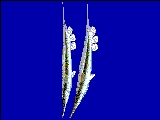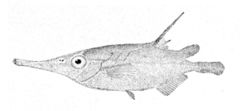
Centriscidae
Encyclopedia
Centriscidae is the family of snipefish
es, shrimpfish
es, and bellowfish
es. A small family, consisting of only about a dozen marine species, they are of an unusual appearance, as reflected by the common names. The members of the genera Aeoliscus and Centriscus are restricted to relatively shallow, tropical parts of the Indo-Pacific
, while the remaining species mainly are found in deeper parts of tropical, subtropical or southern oceans.
The bodies are highly compressed, and mostly covered with bony plates. The first spine of the dorsal fin
is long and sharp, and displaced to the rear of the body; two additional spines, the rest of the dorsal fin, and the caudal fin have all moved to the ventral side of the fish. The snout is also long and narrow, and the small mouth at the end has no teeth. All species are small, no more than 34 centimetres (13.4 in).
As if the shape were not strange enough, centriscids also swim head down. The reason for this is unclear; while some species blend in with sea grass, others live on coral reef
s, where there is no apparent advantage to vertical positioning. They feed on zooplankton
.
places it in Macroramphosinae but FishBase
places it in Centriscinae.
Snipefish
The snipefishes are two species of fishes found in tropical and subtropical oceans at depth down to . According to FishBase, they are part of the family Centriscidae, but some authorities split that family, in which case the genus Macroramphosus is in the family Macroramphosidae...
es, shrimpfish
Shrimpfish
Shrimpfish, also called razorfish, are five small species of marine fish in the subfamily Centriscinae of the family Centriscidae...
es, and bellowfish
Bellowfish
The bellowfishes or bellowsfishes are fishes found in deeper parts of the temperate southern oceans, although the longspine bellowfish has been recorded as far north as New Caledonia and Madagascar...
es. A small family, consisting of only about a dozen marine species, they are of an unusual appearance, as reflected by the common names. The members of the genera Aeoliscus and Centriscus are restricted to relatively shallow, tropical parts of the Indo-Pacific
Indo-Pacific
The Indo-Pacific is a biogeographic region of the Earth's seas, comprising the tropical waters of the Indian Ocean, the western and central Pacific Ocean, and the seas connecting the two in the general area of Indonesia...
, while the remaining species mainly are found in deeper parts of tropical, subtropical or southern oceans.
The bodies are highly compressed, and mostly covered with bony plates. The first spine of the dorsal fin
Dorsal fin
A dorsal fin is a fin located on the backs of various unrelated marine and freshwater vertebrates, including most fishes, marine mammals , and the ichthyosaurs...
is long and sharp, and displaced to the rear of the body; two additional spines, the rest of the dorsal fin, and the caudal fin have all moved to the ventral side of the fish. The snout is also long and narrow, and the small mouth at the end has no teeth. All species are small, no more than 34 centimetres (13.4 in).
As if the shape were not strange enough, centriscids also swim head down. The reason for this is unclear; while some species blend in with sea grass, others live on coral reef
Coral reef
Coral reefs are underwater structures made from calcium carbonate secreted by corals. Coral reefs are colonies of tiny living animals found in marine waters that contain few nutrients. Most coral reefs are built from stony corals, which in turn consist of polyps that cluster in groups. The polyps...
s, where there is no apparent advantage to vertical positioning. They feed on zooplankton
Zooplankton
Zooplankton are heterotrophic plankton. Plankton are organisms drifting in oceans, seas, and bodies of fresh water. The word "zooplankton" is derived from the Greek zoon , meaning "animal", and , meaning "wanderer" or "drifter"...
.
Species
There are thirteen species in five genera and two subfamilies. In some classifications the subfamily Macroramphosinae is raised to the level of family, Macroramphosidae. The placement of the genus Centriscops is unclear: ITISItis
Itis may refer to* Integrated Taxonomic Information System, a partnership designed to provide consistent and reliable information on the taxonomy of biological species...
places it in Macroramphosinae but FishBase
FishBase
FishBase is a comprehensive database of information about fish species . It is the largest and most extensively accessed online database on adult finfish on the web...
places it in Centriscinae.
- Subfamily CentriscinaeShrimpfishShrimpfish, also called razorfish, are five small species of marine fish in the subfamily Centriscinae of the family Centriscidae...
(shrimpfishes)- Genus Aeoliscus
- Speckled Shrimpfish, Aeoliscus punctulatus (Bianconi, 1855).
- RazorfishAeoliscus strigatusAeoliscus strigatus, also known as the razorfish, is a member of the family Centriscidae of the order Gasterosteiformes. This unique fish adopts a head-down tail-up position as an adaptation for hiding among sea urchin spines....
, Aeoliscus strigatus (Günther, 1861).
- Genus Centriscops
- Banded BellowsfishBanded bellowsfishThe banded bellowsfish, banded yellowfish, banded snipefish, or bluebanded bellowsfish, Centriscops humerosus, is a species of fish of the family Centriscidae, found in southern oceans at depths of...
, Centriscops humerosus (Richardson, 1846).
- Banded Bellowsfish
- Genus Centriscus
- Smooth razorfish, Centriscus cristatus (De VisCharles Walter De VisCharles Walter de Vis , known as Devis before about 1882, was an English zoologist and ornithologist...
, 1885). - Grooved razorfish, Centriscus scutatus Linnaeus, 1758.
- Smooth razorfish, Centriscus cristatus (De Vis
- Genus Aeoliscus
- Subfamily Macroramphosinae
- Genus MacroramphosusSnipefishThe snipefishes are two species of fishes found in tropical and subtropical oceans at depth down to . According to FishBase, they are part of the family Centriscidae, but some authorities split that family, in which case the genus Macroramphosus is in the family Macroramphosidae...
- Slender snipefishSlender snipefishThe slender snipefish or snipefish is a snipefish of the genus Macroramphosus. It is found in tropical oceans around the world at depths of . Its length is up to .-References:...
, Macroramphosus gracilis (LoweRichard Thomas LoweRichard Thomas Lowe was a British botanist, ichthyologist, malacologist, and clergyman. In 1825 he graduated from Christ's College, Cambridge and in the same year took holy orders. He became a clergyman in the Madeira Islands in 1832, where he was a part-time naturalist, extensively studying the...
, 1839). - Longspine snipefishLongspine snipefishThe longspine snipefish, bellowfish, common bellowsfish, snipe-fish, snipefish, spine trumpet fish, or trumpetfish, Macroramphosus scolopax, is a snipefish of the genus Macroramphosus, found in the Atlantic, Indian, and west Pacific Oceans, at depths of...
, Macroramphosus scolopax (Linnaeus, 1758).
- Slender snipefish
- Genus NotopogonBellowfishThe bellowfishes or bellowsfishes are fishes found in deeper parts of the temperate southern oceans, although the longspine bellowfish has been recorded as far north as New Caledonia and Madagascar...
- Notopogon armatus (Sauvage, 1879).
- Notopogon endeavouri Mohr, 1937.
- Orange bellowsfishOrange bellowsfishThe orange bellowsfish, Notopogon fernandezianus, is a species of fish of the family Centriscidae, found in all southern oceans, at depths of . Its length is up to .-References:...
, Notopogon fernandezianus (Delfin, 1899). - Crested bellowfishCrested bellowfishThe crested bellowfish, Notopogon lilliei, is a species of fish from the family Centriscidae, found in the south west Pacific, western Indian, and south east Atlantic Oceans at depths of...
, Notopogon lilliei Regan, 1914. - Longsnout bellowfish, Notopogon macrosolen Barnard, 1925.
- Longspine bellowfish, Notopogon xenosoma Regan, 1914.
- Genus Macroramphosus

